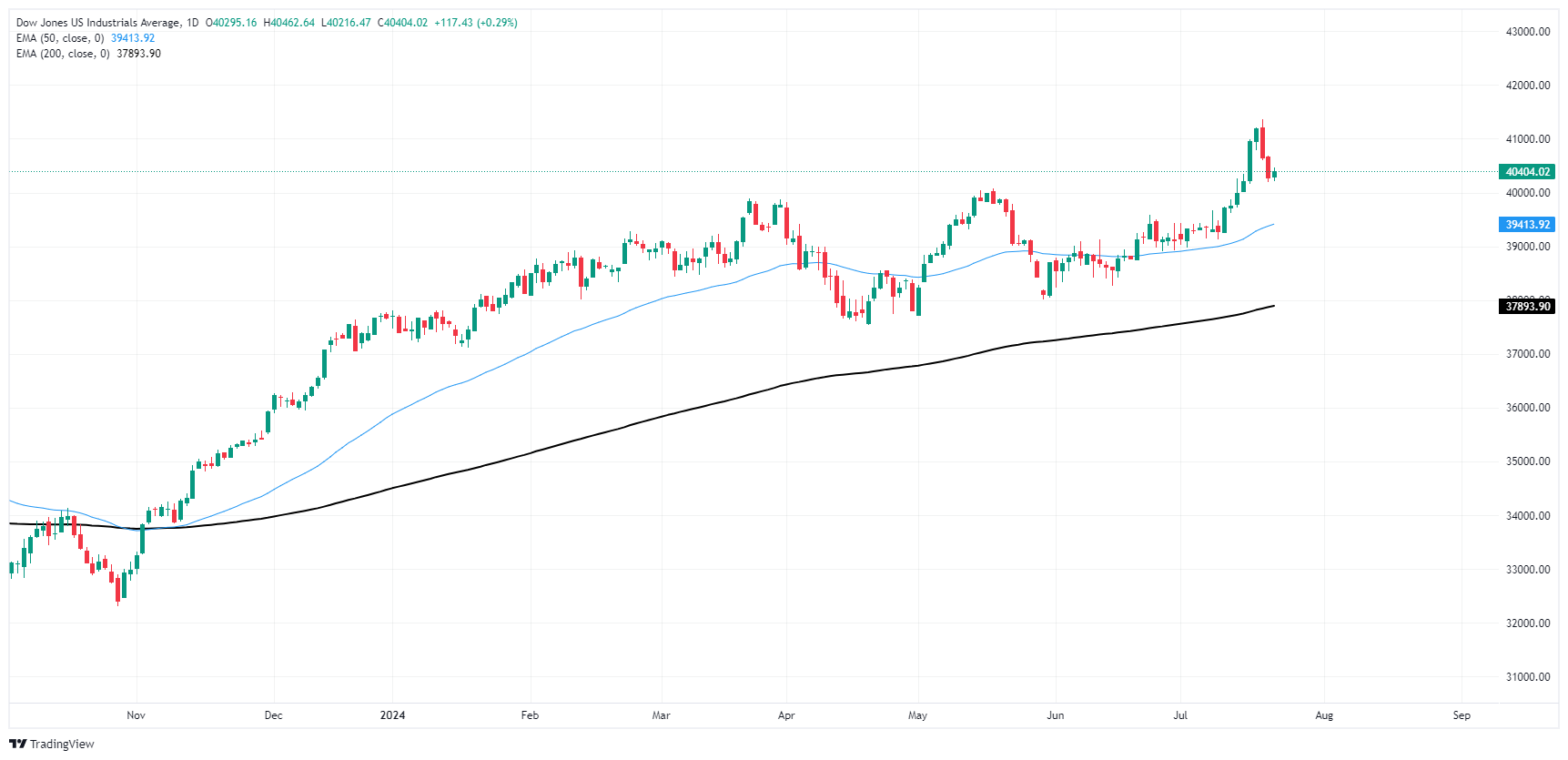- Dow Jones climbed around one hundred points amid tepid Monday markets.
- Broad-market hopes for a Fed rate cut have run into the ceiling.
- Key US activity and inflation data looms ahead later in the week.
The Dow Jones Industrial Average (DJIA) climbed around one hundred points on Monday in a thin recovery from last week’s late pullback. Equities are drifting into the high end, but the Dow Jones is holding steady as investors gear up for a fresh round of key US data due later in the week.
According to the CME’s FedWatch Tool, rate markets are still pricing in an all-but-certain rate cut from the Federal Reserve (Fed) in September. Rate traders are pricing in 95% odds of at least a quarter-point rate trim when the Federal Open Market Committee (FOMC) meets on September 18.
A fresh round of S&P Global Manufacturing and Services Purchasing Managers Index (PMI) figures are due on Wednesday, followed by a Gross Domestic Product print on Thursday. Friday will wrap up the trading week with an update to the Personal Consumption Expenditure – Price Index (PCE) inflation figures.
Market participants looking for a Fed rate cut will be hoping for easing figures, and Wednesday’s Services PMI for July is expected to ease to 54.4 from 55.3. Annualized Q2 US GDP is expected to accelerate to 1.9% from 1.4%, and Friday’s PCE Price Index inflation for June is broadly expected to tick higher on the near end of the curve, forecast to print at 0.1% MoM versus the previous 0.0% print.
Dow Jones news
About a third of the Dow Jones is in the red on Monday, with concentrated losses in major names keeping prices more subdued across the wider index. Verizon Communications Inc. (VZ) reported a miss against quarterly revenue estimates, falling nearly 7% to $38.78 per share. On the high side, Nike Inc. (NKE) recovered ground on Monday, climbing 3.3% to $75.09 per share.
Dow Jones technical outlook
The Dow Jones is cycling familiar levels on Monday, but leaning into the bullish side. Intraday price action is crimped below 40,500.00, while a near-term floor is priced in near 40,200.00. Despite a rapid pullback from record highs last week, the Dow Jones is still trading firmly north of the 200-day Exponential Moving Average (EMA) at 37,893.31, and it won’t take much of a push for a fresh round of bidding to test into new record prices near 41,500.00.
Dow Jones five minute chart
Dow Jones daily chart
Fed FAQs
Monetary policy in the US is shaped by the Federal Reserve (Fed). The Fed has two mandates: to achieve price stability and foster full employment. Its primary tool to achieve these goals is by adjusting interest rates. When prices are rising too quickly and inflation is above the Fed’s 2% target, it raises interest rates, increasing borrowing costs throughout the economy. This results in a stronger US Dollar (USD) as it makes the US a more attractive place for international investors to park their money. When inflation falls below 2% or the Unemployment Rate is too high, the Fed may lower interest rates to encourage borrowing, which weighs on the Greenback.
The Federal Reserve (Fed) holds eight policy meetings a year, where the Federal Open Market Committee (FOMC) assesses economic conditions and makes monetary policy decisions. The FOMC is attended by twelve Fed officials – the seven members of the Board of Governors, the president of the Federal Reserve Bank of New York, and four of the remaining eleven regional Reserve Bank presidents, who serve one-year terms on a rotating basis.
In extreme situations, the Federal Reserve may resort to a policy named Quantitative Easing (QE). QE is the process by which the Fed substantially increases the flow of credit in a stuck financial system. It is a non-standard policy measure used during crises or when inflation is extremely low. It was the Fed’s weapon of choice during the Great Financial Crisis in 2008. It involves the Fed printing more Dollars and using them to buy high grade bonds from financial institutions. QE usually weakens the US Dollar.
Quantitative tightening (QT) is the reverse process of QE, whereby the Federal Reserve stops buying bonds from financial institutions and does not reinvest the principal from the bonds it holds maturing, to purchase new bonds. It is usually positive for the value of the US Dollar.















